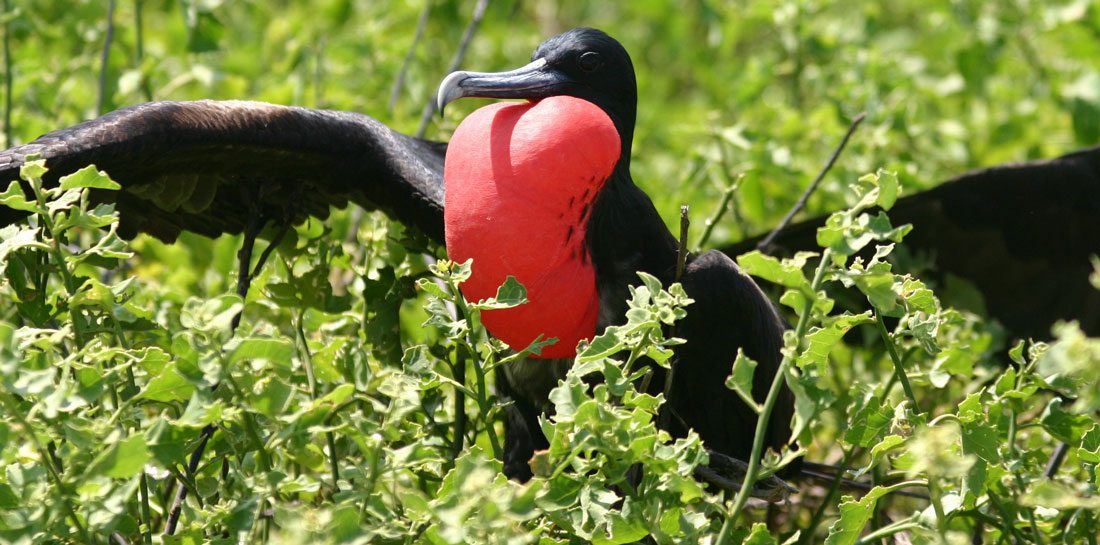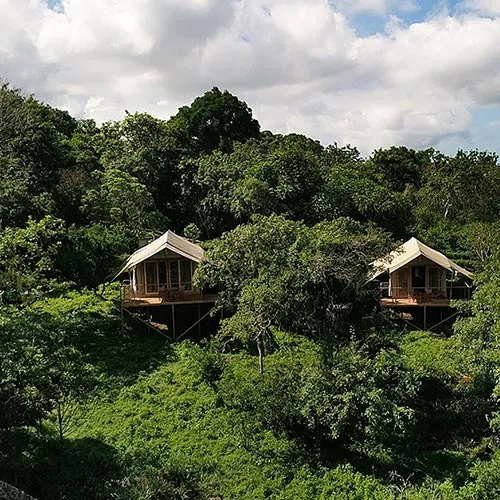
What differentiates the seas of the temperate northern hemisphere from those of the tropics? One of the first differences that comes to my mind are the presence of frigatebirds on your Galapagos tour. Like Pterodactyls soaring ominously-yet-gallantly in characteristic silhouette, high, high in the sky; their profiles, which can be experienced mainly over pantropical oceans, are an iconic image wherever they are found.
Frigatebirds are a spectacle to behold… along the shores of South America, it’s common to see them flying over fishing villages where they often swoop down acrobatically to local fishing yachts at sea to pester sailors for a morsel or two. As the boats reach the beach, they circle the catch in astounding numbers like gigantic flies. Where do they come from? In what magic cauldron were these creatures created? One such cauldron is, of course, the Galapagos Islands.
Where to see Frigatebirds in the Galapagos
A typical Galapagos vacation will organize an itinerary that includes North Seymour, where you come so close to frigatebirds you can actually see the shimmering coloration of the sheen that reflects off the males’ elongated dorsal feathers. This sheen, which is indistinguishable in the field (even with binoculars!), is actually one of the features that differentiates the two species of frigatebirds that nest in the archipelago. When seeing them this close, you can easily notice that these feathers emanate either a shiny green (the Great Frigatebird) or a glimmering purple (the Magnificent Frigatebird). Not even the most consummate birder could tell the difference otherwise.
The helium balloon
Now frigatebirds might not be a prime attraction of the Galapagos if it weren’t for the males’ bizarre “guttural pouch”. The name sounds unappealing for sure, but once you see this phenomenon of nature live, you’ll be taken by the sight. Males are able to inflate a scraggly “bag” that normally lies unobtrusively along their throats into a gigantic bright-red balloon.
They spend hours sucking-up air in order to expand them to become as plump as possible, with the sole intention of attracting females, who, flying above, are constantly on the lookout to see which seems the sexiest. When they finally make their choice, the intrigued ‘damsel’ alights alongside her mate. We gather that the redder and larger, the more irresistible, but who knows what makes each tick!
Frigatebird nests
Spotting Frigatebirds on your Galapagos tour ranks as a true highlight. Their colonies are to be found in arid Palo Santo forests, where nests are placed anywhere from the treetops to right on the ground. To build them, these birds use their own sticky defecation, called guano, to firmly cement together what looks like a loose pile of sticks. All of this, including that phantom-like silhouette, the mating males, their guttural pouches, and disheveled babies, their nests, are yet another spectacle of nature you can only experience in the Galapagos Islands.
Palo Santo, the holy stick
Bursera graveolens, known in Spanish as palo santo (“holy stick”), is a wild tree native to Mexico and the Yucatán Peninsula to Peru and Venezuela, that inhabits large parts of South America, including the Galápagos Islands.
The tree belongs to the same family (Burseraceae) as frankincense and myrrh (the incense famously brought to the baby Jesus by the Three Wise Men). It is widely used in folk medicine for stomach ache and as liniment for rheumatism.
Producing essential oil from the sap of the palo santo is growing in South America, particularly for burning sticks and incense.
The use of palo santo by communities in South America, especially in Ecuador, goes back centuries. Here, it is used to ward off bad energy. There’s a saying: “Palo santo para limpiar tu casa de la mala energia, palo santo para la buena suerte” or “Palo santo to clean your house of bad energy, palo santo for good luck”. Its use reportedly dates back to the times of Inca. Today it is commonly used as an incense, giving off an aroma reminiscent of baked apples or burnt sugar, but its popularity as an essential oil is also on the up.
Plan your Galapagos vacation!
See our Safari Holidays for our suggested Galapagos diving itineraries and recommended activities.
